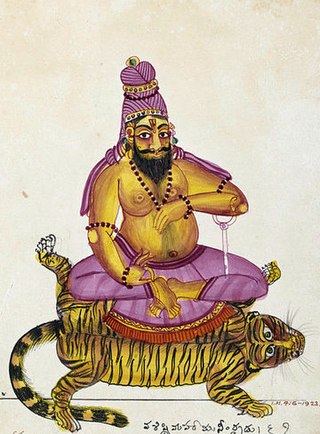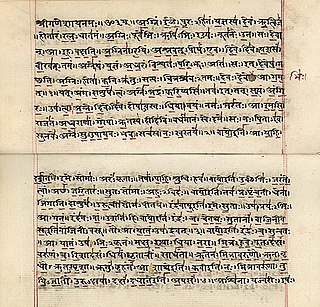
Bal Gangadhar Tilak, endeared as Lokmanya, was an Indian nationalist, teacher, and an independence activist. He was one third of the Lal Bal Pal triumvirate. The British colonial authorities called him "The father of the Indian unrest". He was also conferred with the title of "Lokmanya", which means "accepted by the people as their leader". Mahatma Gandhi called him "The Maker of Modern India".
In the Vedic tradition, soma is a ritual drink of importance among the early Vedic Indo-Aryans. The Rigveda mentions it, particularly in the Soma Mandala. Gita mentions the drink in chapter 9. It is equivalent to the Iranian haoma.
Ribhus is an ancient Indian word whose meaning evolved over time. In early layers of the Vedic literature, it referred to a sun deity. It evolved to being a wind deity, thereafter referred to three male artisans whose abilities and austerities make them into divinities in later Vedic texts. Their individual names were Ribhu, Vaja and Vibhvan, but they were collectively called Rhibhus or Ribhus. Their name's meaning is "clever, skillful, inventive, prudent", cognate to Latin labor and Gothic arb-aiþs "labour, toil", and perhaps to English elf.

The historical Vedic religion, also called Vedicism or Vedism, and sometimes ancient Hinduism or Vedic Hinduism, constituted the religious ideas and practices prevalent amongst some of the Indo-Aryan peoples of the northwest Indian subcontinent during the Vedic period. These ideas and practices are found in the Vedic texts, and some Vedic rituals are still practiced today. The Vedic religion is one of the major traditions which shaped modern Hinduism, though present-day Hinduism is significantly different from the historical Vedic religion.

In Greek mythology, the Hyperboreans were a mythical people who lived in the far northern part of the known world. Their name appears to derive from the Greek ὑπέρ Βορέᾱ, "beyond Boreas". Some scholars prefer a derivation from ὑπερφέρω.

David Frawley is an American Hindutva activist and a teacher of Hinduism.
Vedic Sanskrit, also simply referred as the Vedic language, is an ancient language of the Indo-Aryan subgroup of the Indo-European language family. It is attested in the Vedas and related literature compiled over the period of the mid-2nd to mid-1st millennium BCE. It is orally preserved, predating the advent of writing by several centuries.
Dasa is a Sanskrit word found in ancient Indian texts such as the Rigveda, Pali canon, and theArthashastra. The term may mean "slave", "enemy" or "servant," but Dasa or Das can also have the following connotations: "slave of god", "devotee," "votary" or "one who has surrendered to God." Dasa may be a suffix of a given name to indicate a "slave" of a revered person or a particular deity.
The Indo-Aryan migrations were the migrations into the Indian subcontinent of Indo-Aryan peoples, an ethnolinguistic group that spoke Indo-Aryan languages. These are the predominant languages of today's Bangladesh, Maldives, Nepal, North India, Pakistan, and Sri Lanka.

The Poureai alias Purus were an Indo-Aryan tribal alliance or a confederation of tribes that existed between c. 1700–1400 BCE. There were several factions of Purus, one being the Bharatas. The Purus and the Bharatas were the two most prominent tribes in most of the Rigveda. The chief of tribe was called Rajan The Purus rallied many other groups against King Sudas of the Bharata, but were defeated in the Battle of the Ten Kings.
Jean Haudry was a French linguist and Indo-Europeanist. Haudry was generally regarded as a distinguished linguist by other scholars, although he was also criticized for his political proximity with the far-right. Haudry's L'Indo-Européen, published in 1979, remains the reference introduction to the Proto-Indo-European language written in French.

Vasishtha is one of the oldest and revered Vedic rishis or sages, and one of the Saptarishis. Vasishtha is credited as the chief author of Mandala 7 of the Rigveda. Vasishtha and his family are mentioned in Rigvedic verse 10.167.4, other Rigvedic mandalas and in many Vedic texts. His ideas have been influential and he was called the first sage of the Vedanta school of Hindu philosophy by Adi Shankara.

The horse has been present in the Indian subcontinent from at least the middle of the second millennium BC, more than two millennia after its domestication in Central Asia. The earliest uncontroversial evidence of horse remains on the Indian Subcontinent date to the early Swat culture. While horse remains and related artifacts have been found in Late Harappan sites, indicating that horses may have been present at Late Harappan times, horses did not play an essential role in the Harappan civilisation, in contrast to the Vedic period. The importance of the horse for the Indo-Aryans is indicated by the Sanskrit word Ashva, "horse," which is often mentioned in the Vedas and Hindu scriptures.
The Bharatas were an early Vedic tribe that existed in the latter half of the second millennium B.C.E. The earliest mentioned location of the Bharatas was on the Sarasvatī River. Led by the tribal king Divodāsa, the Bharatas moved through the Hindu Kush mountains and defeated Śambara. Divodāsa's descendant, Sudās, won the Battle of the Ten Kings against a Pūru-led coalition, after which the initial compilation of hymns of the R̥gveda was carried out. After the battle, the Bharatas and other Pūru clans eventually formed the Kuru kingdom, which was the first attested state in Indian history.
Indigenous Aryanism, also known as the Indigenous Aryans theory (IAT) and the Out of India theory (OIT), is the conviction that the Aryans are indigenous to the Indian subcontinent, and that the Indo-European languages radiated out from a homeland in India into their present locations. It is a "religio-nationalistic" view of Indian history, and propagated as an alternative to the established migration model, which considers the Pontic–Caspian steppe to be the area of origin of the Indo-European languages.

The Vedic period, or the Vedic age, is the period in the late Bronze Age and early Iron Age of the history of India when the Vedic literature, including the Vedas, was composed in the northern Indian subcontinent, between the end of the urban Indus Valley Civilisation and a second urbanisation, which began in the central Indo-Gangetic Plain c. 600 BCE. The Vedas are liturgical texts which formed the basis of the influential Brahmanical ideology, which developed in the Kuru Kingdom, a tribal union of several Indo-Aryan tribes. The Vedas contain details of life during this period that have been interpreted to be historical and constitute the primary sources for understanding the period. These documents, alongside the corresponding archaeological record, allow for the evolution of the Indo-Aryan and Vedic culture to be traced and inferred.

Arctic exploration is the physical exploration of the Arctic region of the Earth. It refers to the historical period during which mankind has explored the region north of the Arctic Circle. Historical records suggest that humankind have explored the northern extremes since 325 BC, when the ancient Greek sailor Pytheas reached a frozen sea while attempting to find a source of the metal tin. Dangerous oceans and poor weather conditions often fetter explorers attempting to reach polar regions, and journeying through these perils by sight, boat, and foot has proven difficult.

The Rigveda or Rig Veda is an ancient Indian collection of Vedic Sanskrit hymns (sūktas). It is one of the four sacred canonical Hindu texts (śruti) known as the Vedas. Only one Shakha of the many survive today, namely the Śakalya Shakha. Much of the contents contained in the remaining Shakhas are now lost or are not available in the public forum.

The Epic-Puranic chronology is a timeline of Hindu mythology based on the Itihasa and the Puranas. These texts have an authoritaive status in Indian tradition, and narrate cosmogeny, royal chronologies, myths and legendary events. The central dates here are the Kurukshetra War and the start of the Kali Yuga. The Epic-Puranic chronology is referred to by proponents of Indigenous Aryans to propose an earlier dating of the Vedic period, and the spread of Indo-European languages out of India, arguing that "the Indian civilization must be viewed as an unbroken tradition that goes back to the earliest period of the Sindhu-Sarasvati Valley traditions ."

The North European hypothesis was a linguistic and archaeological theory that tried to explain the spread of the Indo-European languages in Europe and parts of Asia by locating the original homeland (Urheimat) in southern Scandinavia or in the North German Plain. This hypothesis, advanced by Karl Penka, Hermann Hirt, Gustaf Kossinna and others, had some success in the late 19th century and the early 20th century, and was endorsed by Nazism, but is today considered outdated by the majority of the academics, who tend to favor the Kurgan hypothesis.












